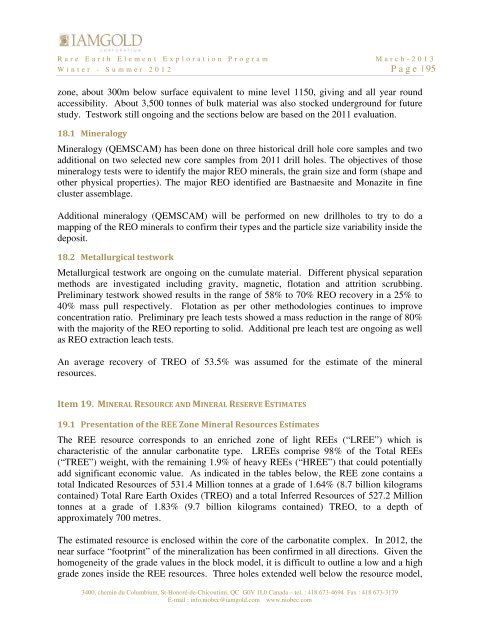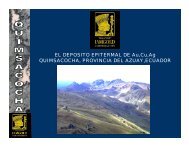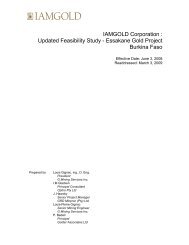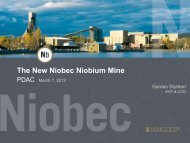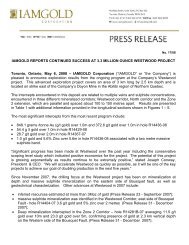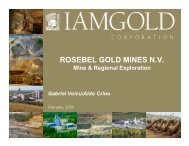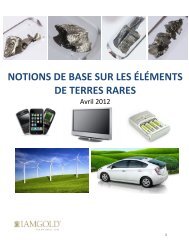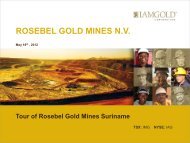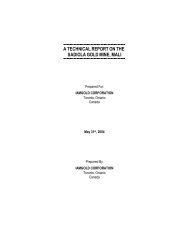NI 43-101 Technical report, Surface diamond drilling ... - Iamgold
NI 43-101 Technical report, Surface diamond drilling ... - Iamgold
NI 43-101 Technical report, Surface diamond drilling ... - Iamgold
You also want an ePaper? Increase the reach of your titles
YUMPU automatically turns print PDFs into web optimized ePapers that Google loves.
R a r e E a r t h E l e m e n t E x p l o r a t i o n P r o g r a m M a r c h - 2 0 1 3<br />
W i n t e r - S u m m e r 2 0 1 2 P a g e | 95<br />
zone, about 300m below surface equivalent to mine level 1150, giving and all year round<br />
accessibility. About 3,500 tonnes of bulk material was also stocked underground for future<br />
study. Testwork still ongoing and the sections below are based on the 2011 evaluation.<br />
18.1 Mineralogy<br />
Mineralogy (QEMSCAM) has been done on three historical drill hole core samples and two<br />
additional on two selected new core samples from 2011 drill holes. The objectives of those<br />
mineralogy tests were to identify the major REO minerals, the grain size and form (shape and<br />
other physical properties). The major REO identified are Bastnaesite and Monazite in fine<br />
cluster assemblage.<br />
Additional mineralogy (QEMSCAM) will be performed on new drillholes to try to do a<br />
mapping of the REO minerals to confirm their types and the particle size variability inside the<br />
deposit.<br />
18.2 Metallurgical testwork<br />
Metallurgical testwork are ongoing on the cumulate material. Different physical separation<br />
methods are investigated including gravity, magnetic, flotation and attrition scrubbing.<br />
Preliminary testwork showed results in the range of 58% to 70% REO recovery in a 25% to<br />
40% mass pull respectively. Flotation as per other methodologies continues to improve<br />
concentration ratio. Preliminary pre leach tests showed a mass reduction in the range of 80%<br />
with the majority of the REO <strong>report</strong>ing to solid. Additional pre leach test are ongoing as well<br />
as REO extraction leach tests.<br />
An average recovery of TREO of 53.5% was assumed for the estimate of the mineral<br />
resources.<br />
Item 19. MINERAL RESOURCE AND MINERAL RESERVE ESTIMATES<br />
19.1 Presentation of the REE Zone Mineral Resources Estimates<br />
The REE resource corresponds to an enriched zone of light REEs (“LREE”) which is<br />
characteristic of the annular carbonatite type. LREEs comprise 98% of the Total REEs<br />
(“TREE”) weight, with the remaining 1.9% of heavy REEs (“HREE”) that could potentially<br />
add significant economic value. As indicated in the tables below, the REE zone contains a<br />
total Indicated Resources of 531.4 Million tonnes at a grade of 1.64% (8.7 billion kilograms<br />
contained) Total Rare Earth Oxides (TREO) and a total Inferred Resources of 527.2 Million<br />
tonnes at a grade of 1.83% (9.7 billion kilograms contained) TREO, to a depth of<br />
approximately 700 metres.<br />
The estimated resource is enclosed within the core of the carbonatite complex. In 2012, the<br />
near surface “footprint” of the mineralization has been confirmed in all directions. Given the<br />
homogeneity of the grade values in the block model, it is difficult to outline a low and a high<br />
grade zones inside the REE resources. Three holes extended well below the resource model,<br />
3400, chemin du Columbium, St-Honoré-de-Chicoutimi, QC G0V 1L0 Canada – tel. : 418 673-4694 Fax : 418 673-3179<br />
E-mail : info.niobec@iamgold.com www.niobec.com


